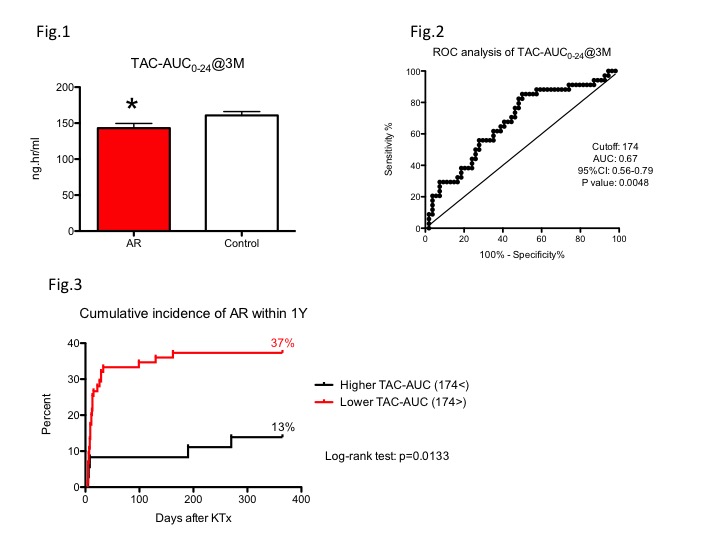Enough Initial Tacrolimus Blood Concentration is Crucial Even with Additional Everolimus in Corticosteroid Early Withdrawal Regimen for Kidney Transplant Recipients
1Kidney Transplant Surgery, Sapporo City General Hospital, Sapporo, Japan, 2Pharmacy, Sapporo City General Hospital, Sapporo, Japan
Meeting: 2020 American Transplant Congress
Abstract number: C-003
Keywords: Induction therapy, Kidney transplantation, Pharmacokinetics, Rejection
Session Information
Session Name: Poster Session C: Kidney Immunosuppression: Induction Therapy
Session Type: Poster Session
Date: Saturday, May 30, 2020
Session Time: 3:15pm-4:00pm
 Presentation Time: 3:30pm-4:00pm
Presentation Time: 3:30pm-4:00pm
Location: Virtual
*Purpose: Everolimus (EVR) in combination with low-dose calcineurin inhibitor has been demonstrated in clinical trials to have comparable efficacy in low immunological risk kidney transplant and association with a reduced rate of viral infections and chronic rejection in long-term. For wider use, we have recently considered de novo use of EVR in addition to our corticosteroid early withdrawal (CSEW) regimen and evaluated an optimal use to suppress graft rejection in short period retrospectively.
*Methods: Enrolled recipients were 37 recipients who developed biopsy proven (86%) and clinical acute rejection (14%) that were treated with steroid pulse therapy within 1 year after living ABO compatible kidney transplantation in our hospital (AR group). Control group was 85 recipients who did not exhibit acute rejection clinicopathlogically. The immunosuppressive regimen consists of tacrolimus (TAC), mycophenolate mofetil, EVR and basiliximab as induction mAB. Patient characteristics at transplant, TAC-AUC (Area Under the Curve) and trough level of EVR at 1, 3, 6, 12 months were analyzed.
*Results: There were no statistical differences in HLA-mismatch, age at transplant, donor age and duration of renal replacement therapy, but TAC-AUC at 3 months after transplant was significantly lower in AR group than control group (143±6.4 vs 160±5.2 p=0.048) (Fig. 1) despite no difference in other time points including trough level of EVR. ROC (receiver operating curve characteristics) analysis showed that cut-off value in TAC-AUC at 3M was 174 with AUC 0.67 and 95%CI 0.56-0.79 and P value 0.0048 (Fig. 2). Finally we found that significant difference in the cumulative incidence of AR between recipients with lower TAC-AUC (<174) and higher TAC-AUC (174<) (Fig. 3). However this difference didn’t effect on graft survival during two year after transplant. (97.3% in lower AUC vs 96.7% in higher AUC. p=0.86)
*Conclusions: High TAC-AUC at 3 months could be most important parameter to prevent early graft rejection in combination with EVR as CSEW principal even in good risk kidney transplant recipients.
To cite this abstract in AMA style:
Sasaki H, Tanabe T, Higuchi H, Tsujimoto T, Harada H. Enough Initial Tacrolimus Blood Concentration is Crucial Even with Additional Everolimus in Corticosteroid Early Withdrawal Regimen for Kidney Transplant Recipients [abstract]. Am J Transplant. 2020; 20 (suppl 3). https://atcmeetingabstracts.com/abstract/enough-initial-tacrolimus-blood-concentration-is-crucial-even-with-additional-everolimus-in-corticosteroid-early-withdrawal-regimen-for-kidney-transplant-recipients/. Accessed December 18, 2025.« Back to 2020 American Transplant Congress

